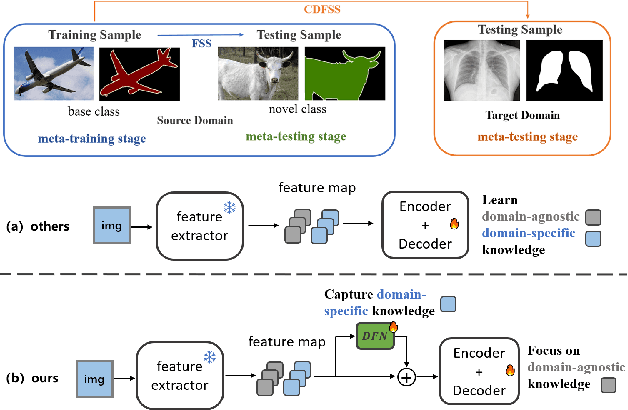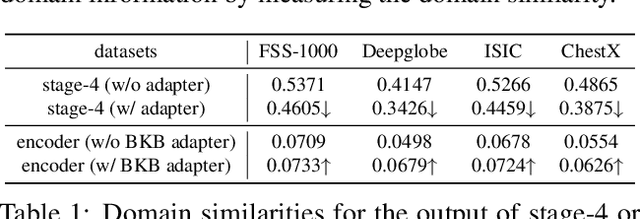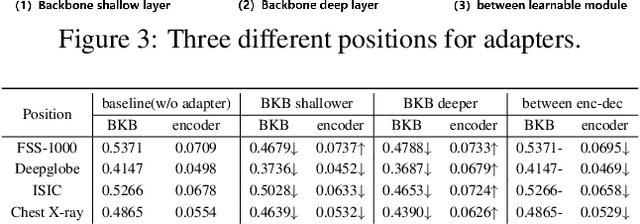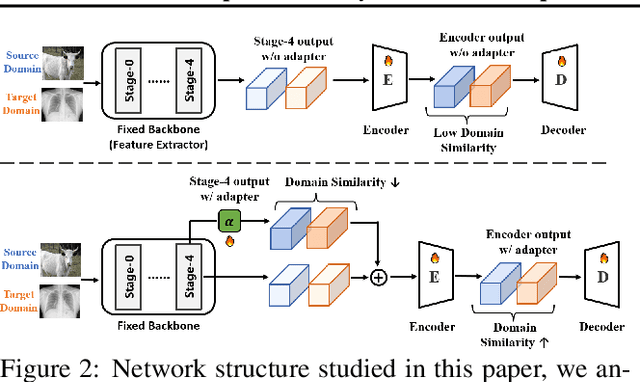Ruixuan Li
Sketch-in-Latents: Eliciting Unified Reasoning in MLLMs
Dec 18, 2025Abstract:While Multimodal Large Language Models (MLLMs) excel at visual understanding tasks through text reasoning, they often fall short in scenarios requiring visual imagination. Unlike current works that take predefined external toolkits or generate images during thinking, however, humans can form flexible visual-text imagination and interactions during thinking without predefined toolkits, where one important reason is that humans construct the visual-text thinking process in a unified space inside the brain. Inspired by this capability, given that current MLLMs already encode visual and text information in the same feature space, we hold that visual tokens can be seamlessly inserted into the reasoning process carried by text tokens, where ideally, all visual imagination processes can be encoded by the latent features. To achieve this goal, we propose Sketch-in-Latents (SkiLa), a novel paradigm for unified multi-modal reasoning that expands the auto-regressive capabilities of MLLMs to natively generate continuous visual embeddings, termed latent sketch tokens, as visual thoughts. During multi-step reasoning, the model dynamically alternates between textual thinking mode for generating textual think tokens and visual sketching mode for generating latent sketch tokens. A latent visual semantics reconstruction mechanism is proposed to ensure these latent sketch tokens are semantically grounded. Extensive experiments demonstrate that SkiLa achieves superior performance on vision-centric tasks while exhibiting strong generalization to diverse general multi-modal benchmarks. Codes will be released at https://github.com/TungChintao/SkiLa.
FAIR: Focused Attention Is All You Need for Generative Recommendation
Dec 17, 2025Abstract:Recently, transformer-based generative recommendation has garnered significant attention for user behavior modeling. However, it often requires discretizing items into multi-code representations (e.g., typically four code tokens or more), which sharply increases the length of the original item sequence. This expansion poses challenges to transformer-based models for modeling user behavior sequences with inherent noises, since they tend to overallocate attention to irrelevant or noisy context. To mitigate this issue, we propose FAIR, the first generative recommendation framework with focused attention, which enhances attention scores to relevant context while suppressing those to irrelevant ones. Specifically, we propose (1) a focused attention mechanism integrated into the standard Transformer, which learns two separate sets of Q and K attention weights and computes their difference as the final attention scores to eliminate attention noise while focusing on relevant contexts; (2) a noise-robustness objective, which encourages the model to maintain stable attention patterns under stochastic perturbations, preventing undesirable shifts toward irrelevant context due to noise; and (3) a mutual information maximization objective, which guides the model to identify contexts that are most informative for next-item prediction. We validate the effectiveness of FAIR on four public benchmarks, demonstrating its superior performance compared to existing methods.
Beyond Higher Rank: Token-wise Input-Output Projections for Efficient Low-Rank Adaptation
Oct 27, 2025



Abstract:Low-rank adaptation (LoRA) is a parameter-efficient fine-tuning (PEFT) method widely used in large language models (LLMs). LoRA essentially describes the projection of an input space into a low-dimensional output space, with the dimensionality determined by the LoRA rank. In standard LoRA, all input tokens share the same weights and undergo an identical input-output projection. This limits LoRA's ability to capture token-specific information due to the inherent semantic differences among tokens. To address this limitation, we propose Token-wise Projected Low-Rank Adaptation (TopLoRA), which dynamically adjusts LoRA weights according to the input token, thereby learning token-wise input-output projections in an end-to-end manner. Formally, the weights of TopLoRA can be expressed as $B\Sigma_X A$, where $A$ and $B$ are low-rank matrices (as in standard LoRA), and $\Sigma_X$ is a diagonal matrix generated from each input token $X$. Notably, TopLoRA does not increase the rank of LoRA weights but achieves more granular adaptation by learning token-wise LoRA weights (i.e., token-wise input-output projections). Extensive experiments across multiple models and datasets demonstrate that TopLoRA consistently outperforms LoRA and its variants. The code is available at https://github.com/Leopold1423/toplora-neurips25.
Is Model Editing Built on Sand? Revealing Its Illusory Success and Fragile Foundation
Oct 01, 2025



Abstract:Large language models (LLMs) inevitably encode outdated or incorrect knowledge. Updating, deleting, and forgetting such knowledge is important for alignment, safety, and other issues. To address this issue, model editing has emerged as a promising paradigm: by precisely editing a small subset of parameters such that a specific fact is updated while preserving other knowledge. Despite its great success reported in previous papers, we find the apparent reliability of editing rests on a fragile foundation and the current literature is largely driven by illusory success. The fundamental goal of steering the model's output toward a target with minimal modification would encourage exploiting hidden shortcuts, rather than utilizing real semantics. This problem directly challenges the feasibility of the current model editing literature at its very foundation, as shortcuts are inherently at odds with robust knowledge integration. Coincidentally, this issue has long been obscured by evaluation frameworks that lack the design of negative examples. To uncover it, we systematically develop a suite of new evaluation methods. Strikingly, we find that state-of-the-art approaches collapse even under the simplest negation queries. Our empirical evidence shows that editing is likely to be based on shortcuts rather than full semantics, calling for an urgent reconsideration of the very basis of model editing before further advancements can be meaningfully pursued.
BoRA: Towards More Expressive Low-Rank Adaptation with Block Diversity
Aug 09, 2025



Abstract:Low-rank adaptation (LoRA) is a parameter-efficient fine-tuning (PEFT) method widely used in large language models (LLMs). It approximates the update of a pretrained weight matrix $W\in\mathbb{R}^{m\times n}$ by the product of two low-rank matrices, $BA$, where $A \in\mathbb{R}^{r\times n}$ and $B\in\mathbb{R}^{m\times r} (r\ll\min\{m,n\})$. Increasing the dimension $r$ can raise the rank of LoRA weights (i.e., $BA$), which typically improves fine-tuning performance but also significantly increases the number of trainable parameters. In this paper, we propose Block Diversified Low-Rank Adaptation (BoRA), which improves the rank of LoRA weights with a small number of additional parameters. Specifically, BoRA treats the product $BA$ as a block matrix multiplication, where $A$ and $B$ are partitioned into $b$ blocks along the columns and rows, respectively (i.e., $A=[A_1,\dots,A_b]$ and $B=[B_1,\dots,B_b]^\top$). Consequently, the product $BA$ becomes the concatenation of the block products $B_iA_j$ for $i,j\in[b]$. To enhance the diversity of different block products, BoRA introduces a unique diagonal matrix $\Sigma_{i,j} \in \mathbb{R}^{r\times r}$ for each block multiplication, resulting in $B_i \Sigma_{i,j} A_j$. By leveraging these block-wise diagonal matrices, BoRA increases the rank of LoRA weights by a factor of $b$ while only requiring $b^2r$ additional parameters. Extensive experiments across multiple datasets and models demonstrate the superiority of BoRA, and ablation studies further validate its scalability.
Adapter Naturally Serves as Decoupler for Cross-Domain Few-Shot Semantic Segmentation
Jun 09, 2025



Abstract:Cross-domain few-shot segmentation (CD-FSS) is proposed to pre-train the model on a source-domain dataset with sufficient samples, and then transfer the model to target-domain datasets where only a few samples are available for efficient fine-tuning. There are majorly two challenges in this task: (1) the domain gap and (2) fine-tuning with scarce data. To solve these challenges, we revisit the adapter-based methods, and discover an intriguing insight not explored in previous works: the adapter not only helps the fine-tuning of downstream tasks but also naturally serves as a domain information decoupler. Then, we delve into this finding for an interpretation, and find the model's inherent structure could lead to a natural decoupling of domain information. Building upon this insight, we propose the Domain Feature Navigator (DFN), which is a structure-based decoupler instead of loss-based ones like current works, to capture domain-specific information, thereby directing the model's attention towards domain-agnostic knowledge. Moreover, to prevent the potential excessive overfitting of DFN during the source-domain training, we further design the SAM-SVN method to constrain DFN from learning sample-specific knowledge. On target domains, we freeze the model and fine-tune the DFN to learn target-specific knowledge specific. Extensive experiments demonstrate that our method surpasses the state-of-the-art method in CD-FSS significantly by 2.69% and 4.68% MIoU in 1-shot and 5-shot scenarios, respectively.
Beyond Zero Initialization: Investigating the Impact of Non-Zero Initialization on LoRA Fine-Tuning Dynamics
May 29, 2025Abstract:Low-rank adaptation (LoRA) is a widely used parameter-efficient fine-tuning method. In standard LoRA layers, one of the matrices, $A$ or $B$, is initialized to zero, ensuring that fine-tuning starts from the pretrained model. However, there is no theoretical support for this practice. In this paper, we investigate the impact of non-zero initialization on LoRA's fine-tuning dynamics from an infinite-width perspective. Our analysis reveals that, compared to zero initialization, simultaneously initializing $A$ and $B$ to non-zero values improves LoRA's robustness to suboptimal learning rates, particularly smaller ones. Further analysis indicates that although the non-zero initialization of $AB$ introduces random noise into the pretrained weight, it generally does not affect fine-tuning performance. In other words, fine-tuning does not need to strictly start from the pretrained model. The validity of our findings is confirmed through extensive experiments across various models and datasets. The code is available at https://github.com/Leopold1423/non_zero_lora-icml25.
The Panaceas for Improving Low-Rank Decomposition in Communication-Efficient Federated Learning
May 29, 2025Abstract:To improve the training efficiency of federated learning (FL), previous research has employed low-rank decomposition techniques to reduce communication overhead. In this paper, we seek to enhance the performance of these low-rank decomposition methods. Specifically, we focus on three key issues related to decomposition in FL: what to decompose, how to decompose, and how to aggregate. Subsequently, we introduce three novel techniques: Model Update Decomposition (MUD), Block-wise Kronecker Decomposition (BKD), and Aggregation-Aware Decomposition (AAD), each targeting a specific issue. These techniques are complementary and can be applied simultaneously to achieve optimal performance. Additionally, we provide a rigorous theoretical analysis to ensure the convergence of the proposed MUD. Extensive experimental results show that our approach achieves faster convergence and superior accuracy compared to relevant baseline methods. The code is available at https://github.com/Leopold1423/fedmud-icml25.
FlowCut: Rethinking Redundancy via Information Flow for Efficient Vision-Language Models
May 26, 2025Abstract:Large vision-language models (LVLMs) excel at multimodal understanding but suffer from high computational costs due to redundant vision tokens. Existing pruning methods typically rely on single-layer attention scores to rank and prune redundant visual tokens to solve this inefficiency. However, as the interaction between tokens and layers is complicated, this raises a basic question: Is such a simple single-layer criterion sufficient to identify redundancy? To answer this question, we rethink the emergence of redundant visual tokens from a fundamental perspective: information flow, which models the interaction between tokens and layers by capturing how information moves between tokens across layers. We find (1) the CLS token acts as an information relay, which can simplify the complicated flow analysis; (2) the redundancy emerges progressively and dynamically via layer-wise attention concentration; and (3) relying solely on attention scores from single layers can lead to contradictory redundancy identification. Based on this, we propose FlowCut, an information-flow-aware pruning framework, mitigating the insufficiency of the current criterion for identifying redundant tokens and better aligning with the model's inherent behaviors. Extensive experiments show that FlowCut achieves superior results, outperforming SoTA by 1.6% on LLaVA-1.5-7B with 88.9% token reduction, and by 4.3% on LLaVA-NeXT-7B with 94.4% reduction, delivering 3.2x speed-up in the prefilling stage. Our code is available at https://github.com/TungChintao/FlowCut
FedRE: Robust and Effective Federated Learning with Privacy Preference
May 08, 2025



Abstract:Despite Federated Learning (FL) employing gradient aggregation at the server for distributed training to prevent the privacy leakage of raw data, private information can still be divulged through the analysis of uploaded gradients from clients. Substantial efforts have been made to integrate local differential privacy (LDP) into the system to achieve a strict privacy guarantee. However, existing methods fail to take practical issues into account by merely perturbing each sample with the same mechanism while each client may have their own privacy preferences on privacy-sensitive information (PSI), which is not uniformly distributed across the raw data. In such a case, excessive privacy protection from private-insensitive information can additionally introduce unnecessary noise, which may degrade the model performance. In this work, we study the PSI within data and develop FedRE, that can simultaneously achieve robustness and effectiveness benefits with LDP protection. More specifically, we first define PSI with regard to the privacy preferences of each client. Then, we optimize the LDP by allocating less privacy budget to gradients with higher PSI in a layer-wise manner, thus providing a stricter privacy guarantee for PSI. Furthermore, to mitigate the performance degradation caused by LDP, we design a parameter aggregation mechanism based on the distribution of the perturbed information. We conducted experiments with text tamper detection on T-SROIE and DocTamper datasets, and FedRE achieves competitive performance compared to state-of-the-art methods.
 Add to Chrome
Add to Chrome Add to Firefox
Add to Firefox Add to Edge
Add to Edge